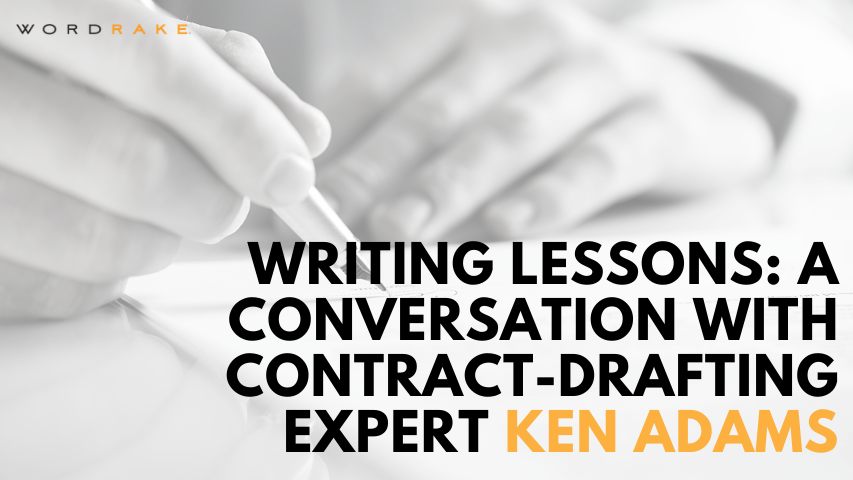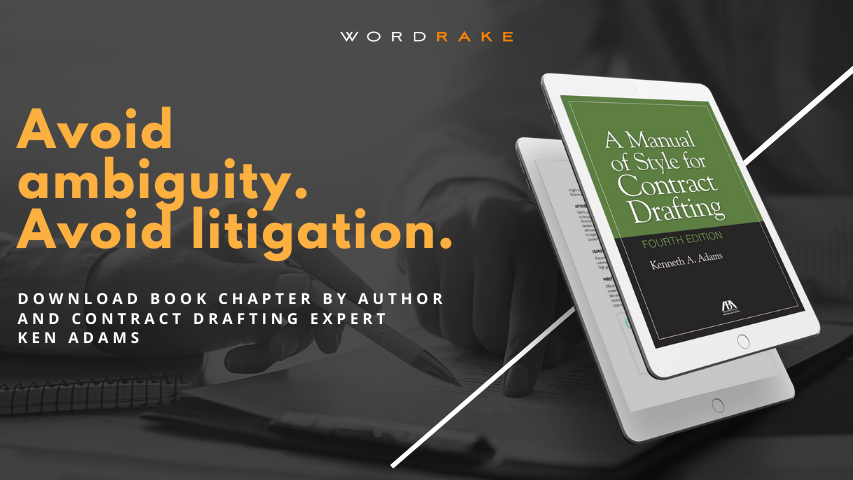Writing can be a source of many things —of inspiration, of learning, or of meditation, for example. Writing is an iterative process, so whether you are hoping to be the next John Grisham or just want to blog, learning from others and then practicing what you have learned can be of immense help.
We recently chatted with Ken Adams, contract-drafting guru and leading authority on contract language. We asked Ken about the writing he does and what he has learned through his focus on contract drafting.
You specialize in how to write contracts clearly, but in the process of developing your expertise and getting the word out, you do other kinds of writing. How would you compare the prose of contracts to other kinds of writing?
If I had to use one word to describe myself, it would be “writer.” I think I’ve logged enough writing miles to be able to do that without appearing delusional. And I write about a specialized kind of writing, so my livelihood is essentially writing squared.
Yes, contract language is limited and stylized—it’s analogous to software code. There’s no narrative—instead, everything is geared to achieving opportunity and addressing risk.
And because a lot is at stake and contracts are closely scrutinized, people fight over shades of meaning that don’t arise in expository writing. Your readers will have a chance to see that for themselves, as thanks to the American Bar Association, you’re making available to them the chapter of my book A Manual of Style for Contract Drafting dealing with syntactic ambiguity. That’s a kind of confusion that arises principally out of the order in which words and phrases are used and how they relate to each other.
Given these differences, it’s appropriate that a specialized word, drafting, is used to refer to writing contracts.
What have you learned about writing from working on four editions of your book A Manual of Style for Contract Drafting?
I’ve learned the lesson I keep learning—that usually your writing is worse than you think it is. If you haven’t gotten into the habit of having your writing savagely critiqued, trust me—it’s safe to assume that your prose needs help. Although it can be mortifying, it’s a gift to be on the receiving end of that sort of treatment—it means that someone cared enough about what you have to say to spend time probing its weaknesses. I’m grateful to those who have helped me in this way, drat them!
In particular, at one point my readers brutalized me for my tendency to stick my recommendations at the end of my account of a given issue. Don’t do that! You’re not writing a whodunit. Lead with the essence of your recommendation, go through your analysis, then state your recommendation in detail.
What about writing for your blog? Is that a different kind of writing?
I write about complicated stuff, so my primary responsibility is to explain everything to myself and, by extension, to my readers. Because I don’t want to bore them, I do my best to have a voice. And I try to be entertaining. That’s not as unlikely as it might seem—thanks to the preposterously dysfunctional nature of traditional contract drafting, there’s a lot to laugh at. Readers have told me that my book and my blog are a source of comic relief. It’s easier to do that on my blog, where the tone is way more casual than it is in my more formal writing.
And on my blog I occasionally indulge in vocabulary that’s a little fancy. I have to keep myself interested—if you always write for the lowest common denominator, things can get a little dreary.
And how about Twitter and LinkedIn?
With my more sober tweets, I tell people what I’m doing and I share my writings. But it’s the in-your-face tweets that I most enjoy: putting on display, and mocking, crappy contract language I encounter in my travels, using the addled stylings of someone who spends way too much time on the interwebz.
As for LinkedIn, I use it to get the word out, and I’ve made useful connections, but I don’t linger, for reasons I explain in this blog post.
How do you see technology playing a role in aiding one’s writing?
Technology certainly can be used to improve writing. After all, I’m chief content officer of LegalSifter, a company that combines artificial-intelligence and expertise—so far, mostly mine—to help with review of draft contracts.
But when it comes to improving your prose, if you don’t have serious prose stylists willing to wreck what you’ve written, your best substitute is, of course, WordRake or one of its competitors. When I know my prose will be scrutinized and I’m eager to eliminate glitches, I run it through WordRake. I used WordRake on the manuscript for the fourth edition of A Manual of Style for Contract Drafting, although it took a while to chew through all 600 pages!
What’s the writing life like in 2021?
This is a difficult time for writers and writing, even if you discount the pandemic. Journalism has been laid to waste, and civic discourse has degraded catastrophically. That doesn’t affect what I do, but what might be relevant is that legal publishing too has been devastated, and social media has fragmented our attention span. That perhaps helps explain why I find myself alone in my corner of the marketplace of ideas. (See this blog post for more on that.) Well, that and plain old inertia!
Download an excerpt of Ken's book "A Manual of Style for Contract Drafting" here.
About Ken Adams
Ken Adams is a scholar, speaker, and blogger on contract drafting, and he’s widely recognized as the leading international authority on how to say clearly in a contract whatever you want to say. He’s the author of A Manual of Style for Contract Drafting, now in its fourth edition. He’s also chief content officer of LegalSifter, a company that combines artificial intelligence and expertise to help with review of contracts. Connect with Ken on LinkedIn and on Twitter.






